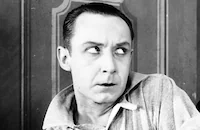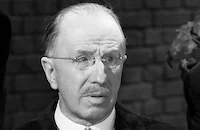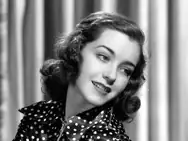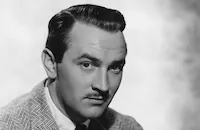Easy Living

Brief Synopsis
Cast & Crew
Mitchell Leisen
Jean Arthur
Edward Arnold
Esther Dale
Luis Alberni
Ray Milland
Film Details
Technical Specs

Synopsis
When millionaire banker J. B. Ball, "The Bull of Broad Street," discovers his wife's purchase of a $58,000 sable coat, he throws it out the window of their Fifth Avenue penthouse and it lands on Mary Smith, ruining her hat. Ball then takes her to a millinery shop and tells her the coat is hers to keep. At work, Ball refuses Mr. Louis Louis' mortgage extension on the Hotel Louis, whose reputation has floundered. When Mary arrives late to work that morning at the publishing office of "The Boys' Constant Companion" wearing a new sable hat and coat, which she claims is only Kolinsky, fake fur, she is fired for questionable morals. Louis, meanwhile, receives word from the milliner that Ball is having an affair and invites Mary to stay at his hotel so she can tell Ball how magnificent it is. Mary accepts unsuspectingly, then goes to the automat with her last dime and meets John Ball, Jr., who has taken a job as a busboy to prove himself to his father. When John causes a riot at the restaurant by opening the food doors so Mary can get a free meal, he is fired. Mary and John then arrive at the Hotel Louis. There, Ball, taking a room because his wife and son have left him, insists on having an elegant dinner sent up to Mary's suite, and she dines with John. The next morning, Wallace Whistling's gossip column tells of Ball's affair, and the Hotel Louis becomes instantly fashionable. When stockbroker E. F. Hulgar comes to Mary's room to get Ball's opinion of the steel market, John jokes that steel will go down, mistakenly causing his father to lose his fortune. The headlines then read that the "Bull of Broad Street" is tottering, and Ball's wife and son return home. When John discloses Mary's leak to the stockbroker, Ball sends the police to find Mary to learn the man's identity. Meanwhile, Mary, realizing her coat is real sable, arrives at the Ball residence to return it, and John and his mother accuse her of being Ball's mistress. John's idea for Mary to reverse the bear market on steel by calling Hulgar saves Ball's fortune, and when Mrs. Ball learns that Mary spent the weekend with John, she is convinced Mary is innocent. Ball hires John as his broker and John gives Mary a job cooking his breakfast.

Director

Mitchell Leisen
Cast

Jean Arthur

Edward Arnold
Esther Dale
Luis Alberni

Ray Milland

Mary Nash
Barlowe Borland

Franklin Pangborn

William Demarest
Andrew Tombes
Harlan Briggs

William B. Davidson
Nora Cecil
Robert Greig
Vernon Dent
Edwin Stanley
Richard Barbee
Bennie Bartlett
Jack Raymond
Adia Ruznetzoff
Florence Dudley
Bob Murphy
Bernard Suss
Rex Moore
John Marshall
Dora Clement
Hayden Stevenson
Sidney Bracy

Arthur Hoyt
Hal K. Dawson
Hector V. Sarno

Gertrude Astor
Hal Greene
Leo Phelps
John Picorri
Forbes Murray
John Dilson
Virginia Dabney
Laura Treadwell
Lois Clinton
Jack Rice
Frances Morris
Jesse Graves
Kathleen Hope Lewis
Helen Huntington
Harold Entwistle

Bud Flannigan
Robert Homans
Stanley Andrews
Leonid Snegoff
Wilson Benge
Harry Worth
George Cowl
Kate Price
Don Brodie
Amelia Falleur
Lu Miller
William Wagner
Francis Sayles
Olaf Hytton
Florence Wix

Marsha Hunt

Lee Bowman
Elsa Connor
Ethel Clayton
Gloria Williams
Nick Lukats
Crew
Edgar Anderson
Travis Banton
Vera Caspary
Hans Dreier
Farciot Edouart
Ernst Fegté
A. E. Freudeman
Doane Harrison
Earl Hayman
Arthur Hornblow Jr.
Arthur Hornblow Jr.
William Lebaron
Boris Morros
Preston Sturges
Ted Tetzlaff
William Thayer
Adolph Zukor

Photo Collections
Videos
Movie Clip



Hosted Intro
Film Details
Technical Specs

Articles
Easy Living (1937)
It's a good thing Sturges did go over Revnes's head, for Easy Living (1937) remains one of the classic screwball comedies of the era. (And for the record, it ended up being produced not by Revnes but by Arthur Hornblow, Jr.) The picture stars Jean Arthur as Mary Smith, a clerk who is riding atop a double-decker bus one day in New York when a $58,000 fur coat falls out of the sky and lands on her head. Turns out it was thrown off a townhouse roof by filthy-rich investor J.B. Ball (Edward Arnold), who was angry at his wife for buying such an expensive coat in the first place. Arthur tries to return the coat but ends up getting even more gifts showered upon her, which ironically leads to her losing her job. With Ray Milland soon in the mix as Arnold's rich-kid son trying to succeed on his own, the result is a delightful screwball full of the usual misunderstandings, coincidences and social satire, but delivered with an abundance of wit, clever plotting, and sharp dialogue.
Sturges was writing unhappily at this point; he'd much rather have been directing, but no studio would yet give him the chance. According to biographer Donald Spoto, Sturges spent his days hanging around in his Paramount office, taking long lunches and wandering about. His writing happened at home, "after dinner and several drinks," as he paced through the house acting out roles and ideas, and dictating to his assistant. This would go on until 4 or 5 am, and after a few hours' sleep, he would start all over again.
Mitchell Leisen was one of the few directors to come from the world of costume design and art direction, having worked on The Thief of Bagdad (1924), The Sign of the Cross (1932) and other lavish Paramount productions of the 1920s and early '30s. As film historian John Baxter has written, "[Leisen's] work exhibits a faultless sense of design, a couturier's feeling for drapery, and an acid cynicism." While Leisen is not usually remembered as one of the top directors of the studio era, he did churn out quite a few very strong pictures including Midnight (1939), Remember the Night (1940, also written by Sturges), Hold Back the Dawn (1941), To Each His Own (1946), No Man of Her Own (1950), and the wonderfully oddball Murder at the Vanities (1934).
In Easy Living, Leisen injected more slapstick than was usual for him. "I was getting bored with the polite drawing room comedies I had been doing, and I decided to cut loose," he later explained. In his biographer's opinion, "Leisen's decision to interpolate slapstick also made the film stronger, because it gave him a visual element to work with in what was otherwise an all-talk script."
For a love scene between Jean Arthur and Ray Milland, Leisen was challenged by the Production Code: "We had to play the love scene with them both lying on this long couch in opposite directions and their heads meeting in the middle because that was the only way we could get it past the censors. There could be no physical contact outside of a kiss."
Leisen paid special attention to the shy and nervous Jean Arthur during pre-production, directing her wardrobe tests and even styling her hair, all as a way of making her feel more at ease. According to Leisen's assistant Eleanor Broder, "Everybody in Hollywood was always talking about how difficult Jean Arthur was to work with, but we didn't have any trouble with her at all. She was on the set on time every morning and she knew all her lines. She was painfully nervous and stuttered terribly through the rehearsals. But the minute the camera turned, she was fine, she became a completely different person, brash and sure of herself."
Arthur delivers an intelligent and breezy performance in Easy Living (Leisen was especially impressed by her "fabulous sense of timing"), but behind the scenes, the actress was engaged in a bitter fight with Columbia Studios chief Harry Cohn. Arthur was under contract to Columbia but was desperately unhappy with the films she had lately been assigned there. She declared her independence and decided to work on a freelance, film-by-film basis.
When Paramount signed her for Easy Living in March, 1937, Cohn became incensed and filed suit to prevent the film from going forward. Arthur's Columbia contract already allowed her to act in two outside films a year, however, so Easy Living was permitted to go on, but the matter of Arthur's contract was still in question. Cohn insisted that she still owed him three years; Arthur countersued in an attempt to get the contract terminated because the studio had not offered her satisfactory roles. Arthur stated in a deposition that when she signed with Columbia in 1933, "I told them that I would not go back into pictures just to make money. I wanted to make quality pictures and to amount to something, or else not be in the business." She added that "being forced to do the kind of things you are ashamed to do is about the worst ill treatment one can possibly go through." In the end, months after Easy Living was finished, Arthur and Cohn reconciled via the intervention of Frank Capra, her frequent director and Cohn's biggest.
Sturges based the hotel in Easy Living on the actual Waldorf Towers, which was a financial failure when it originally opened during the Depression but is now the crown jewel in the Waldorf-Astoria Collection of upscale hotels. In the supporting cast are future Preston Sturges staple William Demarest and ever-amusing comedy player Franklin Pangborn. Look fast for Marsha Hunt.
Producer: Arthur Hornblow, Jr.
Director: Mitchell Leisen
Screenplay: Preston Sturges; Vera Caspary (story)
Cinematography: Ted Tetzlaff
Art Direction: Hans Dreier, Ernst Fegte
Music: Frederick Hollander (uncredited)
Film Editing: Doane Harrison
Cast: Jean Arthur (Mary Smith), Edward Arnold (J.B. Ball/Bull of Broad St.), Ray Milland (John Ball, Jr.), Luis Alberni (Mr. Louis Louis), Mary Nash (Jenny Ball), Franklin Pangborn (Van Buren), Barlowe Borland (Mr. Gurney), William Demarest (Wallace Whistling).
BW-88m.
by Jeremy Arnold
Sources:
John Baxter, Hollywood in the Thirties
David Cherichetti, Hollywood Director
John Oller, Jean Arthur: The Actress Nobody Knew
Donald Spoto, Madcap: The Life of Preston Sturges
Preston Sturges, Preston Sturges

Easy Living (1937)
Easy Living - Jean Arthur & Ray Milland in Mitchell Leisen's 1937 Screwball Comedy - EASY LIVING
Easy Living is a delightful picture with a clever but sweet-hearted script and a parade of lovable, nutty characters. Right in the middle of the Depression, poor girl Jean Arthur and rich boy Ray Milland fall into a fool's paradise of luxury and riches. As is typical with a Preston Sturges script, nothing is the slightest bit credible but it all makes perfect sense. No 30's comedy, not even Gregory La Cava's My Man Godfrey, pegs the contrast between the rich and poor with such effortless good humor.
Synopsis: Impoverished Mary Smith (Jean Arthur) is on her way to work when a phenomenally expensive sable coat suddenly lands on her head. Millionaire stockbroker J.B. Ball, the famous Bull of Wall Street (Edward Arnold), threw the coat from a rooftop to spite his greedy wife Jenny (Mary Nash). J. B. is so pleased with himself for standing up to Jenny that when he meets Mary on the street he gives her the coat outright, and buys her a new hat at a shop belonging to Van Buren (Franklin Pangborn). The coat and the hat are all that are needed to set in motion a maelstrom of mistaken assumptions. Mary is dismissed from her job because her boss assumes that the coat means she's a kept woman. Van Buren jumps to the same conclusion and sells the news of J.B.'s new girlfriend to Mr. Louis Louis (Luis Alberni), a bankrupt hotelier. Louis Louis figures he can revive his business by spreading the word that the Bull of Wall Street's mistress is residing in one of his luxury suites. Mary can't believe it when she's bullied into accepting a lavish set of hotel rooms practically for free, but Louis Louis' gambit pays off. When the word spreads, his hotel quickly fills up with swells that want access to J.B. Ball and his millions. Mary's new apartment fills with free services and goods from retailers hoping to reap big sales. Meanwhile, Mary is falling in love with J.B.'s son, the well intentioned but nearly unemployable John Jr. (Ray Milland). A Wall Street news hound thinks that 'The Bull's mistress' is giving him insider stock tips, leading to a runaway stock sell-off that may ruin J.P.'s business!
Easy Living has a peculiar take on the American economy -- the rich may have all the money, but they share the same idiotic problems with the rest of us. Jovial J.B. Ball is ignored by his wife and humored by his disrespectful servants. He tosses away a priceless coat to teach his wife a lesson, starting a chain reaction that teaches Mary Smith all the wrong lessons. Accused of exhibiting morals unbefitting an editor for a boy's magazine, Mary storms away from her job and is unknowingly assigned a new identity as a pampered mistress. Everybody in New York believes this except Mary and J.B.. Mary is a perfectly intelligent person confused by the mixed signals of vendors who offer their goods gratis but never say why. Like a 'trickle down' miracle, Mary's sudden affluence has literally fallen out of the sky.
J.B. may earn his living through speculation, but the city's high-toned merchants operate in perpetual scam mode. Franklin Pangborn profits from the false notion that Mary is J.B.'s kept woman, and leaves thousands of dollars of merchandise at her apartment on approval. Luis Alberni steals the show with his excitable, malapropism-addled Louis Louis. An ex-chef pretending to be a classy hotelier, Louis Louis says 'soot' when he means 'suite' and instructs his staff to flip lights on and off so his vacant high-rise will appear to be occupied. But his instincts are correct: a scandalous affair involving a millionaire attracts everybody. A typical Louis Louis remark: "You're a sight for an eyesore!".
The recipe for movie comedy has always depended on personalities and chemistry. The casting in Easy Living is masterful, from Mary Nash's wife with her precious closet of fur coats to William Demarest in a bit as a doubting Thomas. Eccentrics clash with deadpans and Eric Blore's butler feels perfectly comfortable insulting J.B. to his face. Edward Arnold had been in pictures since 1916 and was finally shifting from ambitious go-getter types (Come And Get It) to domineering power players. His J.B. is a benign tyrant in need of someone like Mary Smith in his life, as a friend, not a lover.
The inimitable Jean Arthur, the lady with the tinkle-bell voice and incredulous, flirtatious facial expressions, was also a veteran of silent films. She'd made more than 70 features before Easy Living, over 50 of them in starring roles. Yet she's convincing as a guileless young woman and would continue playing 25 and under until way into her 40's. Leisen gets at least a reel of quality film out of an impossibly extravagant hotel suite set, as Mary takes a tour of one incredible art deco room after another, with Louis Louis bumping into glass doors behind her. Jean Arthur never runs out of amazed expressions. On her second tour Mary shows the 'soot' to Ray Milland's John Jr.. They climb all over an ornate, oversized bathtub, not even recognizing what it's for. It looks like a setting for Venus on the Half Shell.
Preston Sturges' comedy writing is every bit as brilliant as the work he did for his self-directed 1940's classics. Critics sometimes fault his over-reliance on slapstick pratfalls, but Sturges whips up a food fight in an automat that's better than anything in a silent comedy. Wearing her $6,000 fur coat but lacking the price of a cup of coffee, Mary wonders what she'll do until John Jr. (who's taken a job bussing tables, don't ask why) takes pity on her and tries to slip her a free meal. A fight with a cafeteria detective opens all of the automat's food windows, and a food riot breaks out. In contrast to glossy 30's movies about rich people in which the poor never intrude, the living conditions in Easy Living's New York are such that nobody can afford to pass up free eats. In the ensuing chaos, it doesn't look as if anybody succeeds in actually eating anything. Ray Milland was just getting good showcase roles and is perfect for Easy Living's clueless John Jr., the heir without a clue. Like Mary, John is essentially a benign innocent, and we're pleased when he begins to figure out what he wants from life.
When an average 30's drama bogs down, the cliché screenwriting solution is to arrange for a cute baby to get sick and need a rare miracle drug. If that doesn't fit, someone will start a run on the bank. Easy Living shows a Wall Street panic instigated by a false rumor originating from, who else, Mary and John Jr.. Living light-years beyond their means but having trouble finding anything to eat, Mary has gone from a Nobody to possessing the ability to alter the course of the economy!
Universal's DVD of the Paramount production Easy Living looks good on DVD, with both its image and track in fine shape. The lone extra is an introduction by TCM's Robert Osborne, but don't watch it before the film: Osborne gives away too much of the story. Easy Living is the kind of movie that raises the spirits; one can't watch it without smiling. The talented Preston Sturges and Jean Arthur made quite a few of those.
For more information about Easy Living, visit Universal Home Entertainment. To order Easy Living, go to TCM Shopping
by Glenn Erickson
Easy Living - Jean Arthur & Ray Milland in Mitchell Leisen's 1937 Screwball Comedy - EASY LIVING
Quotes
Trivia
Notes
In a news item dated October 30, 1935, Hollywood Reporter announced that, as a result of an illness, Adolph Menjou was forced out of the cast of Easy Living. On March 30, 1937, Hollywood Reporter stated that this film's shooting was being postponed until 5 April pending the recovery of director Mitchell Leisen, who underwent minor surgery. A modern biography of Preston Sturges states that this film marked his first assignment at Paramount. According to the biography, Vera Caspary's story differed significantly from Sturges screen adaptation: in her story, the girl steals the mink coat and begins a life of deception, eventually losing the man she loves. Reportedly, all that Sturges kept of the original story was the mink coat, from which he built the plot of Easy Living. In an interview in a modern source, Leisen states that in Sturges' script, all the dialogue between Jean Arthur and Ray Milland in the Automat was said in the doorway as Milland enters and Arthur leaves. It was Leisen's idea to have all the food doors open at once and the "bums" of New York rush in to get free food. During the food fight, one cast member reportedly put pepper in the fan, causing everyone to sneeze. According to Leisen, Preston based the Hotel Louis on New York's Waldorf Towers, which was a financial failure when it was first built during the Depression. Leisen also states that while shooting the bathtub scene in the hotel, Milland actually got stuck in the tub, and although it wasn't in the script, Leisen kept the cameras rolling as Milland tried to get out of the tub, and inserted it in the film. Leisen also reports that in order to get the love scene past the censors, he had to stage it with Milland and Arthur lying on the divan in opposite directions with their heads meeting in the middle, and that there could be no physical contact outside of a kiss. Leisen cast Esther Dale as the secretary because she looked just like Eleanor Broder (apparently his assistant); and the phone gag was based on Broder, who used to get the several telephones on her desk mixed up. Broder, quoted in the modern source, states that Arthur was "terribly concerned" with the way she looked, and Leisen personally directed all her wardrobe and hair tests and styled her hair himself, with the belief that if an actress is satisfield with the way she looks on the screen, she will devote all of her attention to her acting.
According to information in the Twentieth Century-Fox Records of the Legal Department at the UCLA Theater Arts Library, Twentieth Century-Fox officials charged in a series of letters before this film's release, that Easy Living was based on a Hungarian play Der Komet, by Attila Orbok, to which Twentieth Century-Fox owned the motion picture rights. The play had been the basis for the 1933 Fox film My Lips Betray and, more importantly to the officials, was the source for their next picture starring ice-skating star Sonja Henie, Thin Ice, which was due to be released on September 3, 1937. Although Twentieth Century-Fox warned Paramount that unless the release of Easy Living was held up until after the first-run engagements of Thin Ice, they would institute legal action, Twentieth Century-Fox's legal department subsequently determined that they "could not sustain our claim of infringement against Easy Living" and no such action was taken. For more information regarding the dispute, please for Thin Ice.

Miscellaneous Notes
Released in United States 1937
Released in United States 1974
Released in United States June 1990
Released in United States May 2001
Released in United States May 2001 (Shown at Cannes International Film Festival (Retrospective) may 9-20, 2001.)
Released in United States 1974 (Shown at FILMEX: Los Angeles International Film Exposition (The Preston Sturges Movie Marathon) March 28 - April 9, 1974)
Shown at Sydney Film Festival June 8-22, 1990.
Released in United States 1937
Released in United States June 1990 (Shown at Sydney Film Festival June 8-22, 1990.)
Shown at Cannes International Film Festival (Retrospective) may 9-20, 2001.














